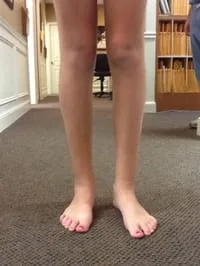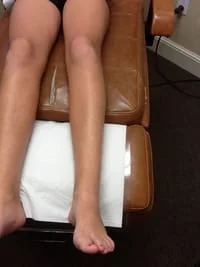
Patient Exam with Knee Malalignment
Patient Gait Analysis with Knee Malalignment
TORSIONAL MALALIGNMENT SYNDROME
(Knee Malalignment)
By: Robert H. Sheinberg, D.P.M.,
D.A.B.F.A.S., F.A.C.F.A.S.
Pain in the knee in adolescents is multifactoral. A condition that is often seen which could be detrimental to the long-term health of the knee is called torsional malalignment syndrome.
This occurs when the upper leg bone (femur) is either structurally malformed in which the lower end of the bone rotates in more than normal relative to the upper portion of the bone. Or, the femur rotates in excessively with little rotation out at the hip level. This combined with the lower leg bone (tibia) rotates out excessively without rotating in at the knee joint or is structurally malformed in which the lower end of the bone is rotated out excessively relative to the upper portion of the bone. This combination causes excessive strain to the knee joint and the kneecap as it articulates with the femur.
There is most likely a hereditary component to this problem. It may be also caused by or certainly exacerbated by the way children sit. Sitting in a “w” posture causes the hips to rotate in and the foot to rotate out. When sitting like this for long periods of time during early growth, the bones may develop a subtle malformation.
This condition is easy to visualize during a clinical examination and a gait analysis. On the exam when the patient is supine the motion of the upper leg is in with little outward rotation. The lower leg bone rotates out with very little in rotation when examining the patient with the knee flexed.
During gait when observing the patient in walking, it is easy to see that the kneecaps squint or point in. At the same time the foot is rotated out, which causes a tremendous torque to the knee.
Most children and adolescents with this condition will often have pain in the knee and if the deformity is severe it will preclude them from performing sports due to the malalignment. It is difficult to compensate for this condition. Trying to rotate the knee out and make it straight causes the leg to rotate out even further. Taking the lower leg and foot and rotating it straight causes the knee to rotate excessively in. This can create even bigger problems.
The best treatment for a mild malalignment problem is to first evaluate whether or not this condition is more structural (bony) or more to soft tissue (muscles and ligaments excessively tight). Bone deformities are difficult to treat. Soft tissue can somewhat respond to physical therapy. This would include working on tight muscles, ligaments and joint capsules to try to improve their flexibility. Also, trying to improve strength in areas that show weakness.
It is important that children, adolescents or adults do activities that do not cause excessive wear and tear on the knee. It is also important to change the way one sits to prevent further stress on the knee. Sitting with their legs minimally flexed with their feet in front minimizes stress to the patellofemoral joint. Avoiding excess running activities such as jogging will also help preserve long-term function of the knee. Instead, swimming or biking minimizes stress to the knee and would give it a better long-term outcome.
Some conditions may be severe, causing not only knee pain but also a significant cosmetically unappealing extremity. When this problem interferes with function, surgery can be contemplated to realign the lower extremity and prevent further damage to the knee. Depending on the deformity, osteotomies (cutting of bone) may be necessary in both the tibia and/or femur.
The photographs below demonstrate internal rotation of the femurs above the knee and external rotation of the tibia-fibula below the knee causing the mal-alignment. The image to the left is a good example of "squinting" of the knees as they point inward in this condition.



